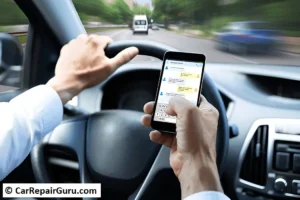
Did you know that distracted driving claimed over 3,500 lives in the U.S. alone in 2025? That’s nearly ten people a day—gone in an instant—because someone glanced at their phone, reached for a sandwich, or zoned out behind the wheel.
Distracted driving is any activity that takes your attention away from the task of safe driving. Whether it’s texting, adjusting your GPS, chatting with passengers, or simply daydreaming, these seemingly harmless actions can turn deadly in seconds.
The dangers of distracted driving are more real today than ever before. With smartphones, infotainment systems, and the pressure to multitask, drivers are more tempted—and more distracted—than at any point in history. This growing problem isn’t just about breaking the rules; it’s about saving lives. Understanding what counts as a distraction, and how to avoid it, could be the most important thing you do before your next drive.
What Is Distracted Driving?
So, what is distracted driving exactly? According to the National Highway Traffic Safety Administration (NHTSA), distracted driving is “any activity that diverts attention from driving.” It’s a form of driver distraction that puts you, your passengers, and others on the road at serious risk.
Distractions come in three main types—and many risky behaviors combine more than one:
- Visual distractions take your eyes off the road. This could be looking at a text, checking your GPS, or even turning to talk to someone in the back seat.
- Manual distractions involve taking your hands off the wheel—like eating, reaching for something, or fiddling with the radio.
- Cognitive distractions happen when your mind isn’t on driving. Maybe you’re thinking about a work meeting, an argument, or just zoning out.
Recognizing the types of distracted driving is the first step in breaking the habit—and staying safe behind the wheel.
Common Causes of Distracted Driving
There’s no shortage of causes of distracted driving—and many of them are surprisingly common, even among experienced drivers. One of the biggest culprits? Texting while driving. It’s one of the most dangerous habits because it combines visual, manual, and cognitive distractions all at once. Just reading a text can take your eyes off the road for five seconds—long enough to drive the length of a football field at 55 mph.
Another major distraction is cell phone use in general. Even hands-free calls can pull your attention away from the task of driving. Then there’s eating or drinking behind the wheel—balancing a coffee cup or unwrapping a snack might not seem like a big deal, but it quickly divides your focus.
Other common causes include talking to passengers, especially when the conversation gets emotional or intense, and adjusting the radio or GPS, which takes your hands and eyes away from the road. Even fatigue or daydreaming—when your mind drifts—can turn into a silent but serious danger.
The Dangers and Consequences

The dangers of distracted driving are both immediate and far-reaching. In 2023 alone, 3,275 people lost their lives, and an estimated 324,819 were injured in crashes involving distracted drivers . These aren’t just numbers—they represent real individuals whose lives were abruptly changed or ended due to a momentary lapse in attention.
Consider the tragic case of Amber Potter, a 23-year-old who, while sending a selfie to her boyfriend, collided with and killed motorcyclist David Sinar. This incident underscores how a brief distraction can lead to irreversible consequences .
Beyond the human toll, there are significant legal repercussions. Many states impose fines ranging from $50 to several hundred dollars for distracted driving offenses . Repeat offenses can lead to increased penalties, including license suspension.
Financially, the impact is substantial. A distracted driving violation can increase your insurance premiums by an average of 23% . This means higher monthly bills, and in some cases, insurers may even cancel policies for repeat offenders .
In essence, the consequences of distracted driving extend beyond immediate accidents—they affect legal standing, financial stability, and, most importantly, human lives. Staying focused behind the wheel isn’t just a personal responsibility; it’s a societal imperative.
High-Risk Groups
While distracted driving is dangerous for everyone, certain groups are at significantly higher risk. Teen distracted driving is especially concerning. Young drivers often lack the experience to react quickly to road hazards, and they’re more likely to use their phones behind the wheel or get distracted by friends in the car. In fact, according to the CDC, teen drivers are more likely than older drivers to be involved in fatal crashes caused by distraction.
New drivers, regardless of age, are also part of the high-risk driver category. Without enough time behind the wheel, they may struggle with multitasking while navigating traffic, GPS systems, or changing radio stations.
Then there are commercial drivers—those who drive for a living. Long hours, tight schedules, and constant communication requirements can increase the likelihood of distractions. Even a brief moment of inattention in a large truck can have devastating consequences.
Understanding these high-risk groups helps in creating targeted awareness campaigns and training programs to make the roads safer for everyone.
How to Prevent Distracted Driving
Knowing the risks is only half the battle—learning how to prevent distracted driving is where real change begins. Fortunately, there are practical steps every driver can take to stay focused and safe.
Start with the basics. Use hands-free technology for calls if you must talk while driving—but keep conversations short and essential. Always set your GPS before driving, so you’re not fiddling with directions mid-ride. And perhaps one of the simplest yet most effective safe driving tips: silence mobile notifications. The fewer distractions that pop up, the easier it is to keep your eyes and mind on the road.
Also, commit to keeping both hands on the wheel—no eating, drinking, or multitasking. For added support, consider using distracted driving prevention tools like apps that block calls or texts while you’re on the road (e.g., DriveMode, LifeSaver, or Android Auto’s “Do Not Disturb” mode).
Parents and schools also play a huge role in prevention. Teaching young drivers about the real-life consequences and encouraging safe habits early on can create lasting change.
At the end of the day, prevention starts with mindfulness. Each time you get behind the wheel, choose safety—because no message, meal, or moment of distraction is worth a life.
Distracted Driving Laws and Regulations

As the dangers of distraction become more apparent, distracted driving laws have tightened across the United States. While specific rules vary by state, many laws focus on two key areas: texting while driving and the use of handheld devices.
Currently, texting while driving laws are in place in nearly every state, making it illegal to read, write, or send messages while operating a vehicle. These laws apply to drivers of all ages and are typically primary offenses—meaning law enforcement can pull you over solely for texting behind the wheel.
In addition, many states have adopted hands-free laws, which require drivers to use voice commands or Bluetooth when making calls. Holding your phone to your ear while driving can lead to fines, points on your license, or worse—depending on where you live.
Penalties for violations can range from modest fines to license suspension for repeat offenses. Some states also impose harsher consequences if distracted driving results in a crash.
By understanding and following these laws, drivers can avoid legal trouble—and more importantly, help make roads safer for everyone.
Role of Technology
Ironically, while technology is often the cause of distraction, it’s also becoming a powerful solution. Today’s driving technology is smarter than ever, offering tools to keep drivers focused and safe.
Many modern vehicles come equipped with driver assistance systems that monitor lane position, detect drowsiness, and even apply the brakes automatically if a collision seems likely. These features aren’t just for luxury models anymore—they’re becoming standard in many new cars and play a key role in reducing distraction-related accidents.
There’s also a growing market of anti-distraction tech designed specifically to help drivers stay alert. Apps like DriveSafe Mode, LifeSaver, and Drivemode can block calls and texts or notify parents when a teen driver picks up their phone while driving. These tools act as digital co-pilots, encouraging smarter habits behind the wheel.
Looking to the future, autonomous driving could take safety to the next level. While we’re not there yet, advancements in self-driving cars could one day eliminate many risks caused by human error—including distraction.
Technology isn’t the enemy—it’s part of the solution. When used wisely, it helps drivers focus, stay alert, and ultimately save lives.
What You Can Do – Be a Part of the Solution
Preventing distracted driving isn’t just the responsibility of lawmakers or car manufacturers—it starts with each of us. By getting involved and spreading distracted driving awareness, you can make a real difference in your community.
Start by having honest conversations with family and friends. Talk to your teens about the risks, set a good example by staying off your phone, and encourage others to do the same. These small actions build a culture of community safety that spreads far beyond your own vehicle.
Support road safety advocacy campaigns in your area or online. Share facts, stories, or videos on social media. The more we talk about the dangers of distracted driving, the more lives we can save.
And if you witness reckless behavior on the road—don’t ignore it. Reporting dangerous driving can protect others and potentially prevent a tragedy.
The fight against distracted driving begins with awareness, but it ends with action. Your voice, your choices, and your example matter. Let’s all be part of the solution—because every safe trip starts with a focused driver.
Conclusion
The dangers of distracted driving are clear—it only takes a moment of inattention to cause lifelong consequences. From texting behind the wheel to daydreaming on a long drive, distractions come in many forms, but the outcomes are often the same: crashes, injuries, and even fatalities.
The good news? We all have the power to prevent distracted driving. By using smart technology, following safe driving tips, obeying the law, and educating those around us, we can create safer roads for everyone.
So here’s your final reminder: stay focused, save lives. Put the phone down, set your GPS before moving, and make driving the only task when you’re behind the wheel. It’s a simple mindset shift—but one that can protect you, your loved ones, and your community.
Every safe journey begins with a choice. Drive safe. Drive smart. Stay alert.
FAQ
Q1: What is the main cause of distracted driving?
The main cause of distracted driving is often texting while driving or general cell phone use. Taking your eyes off the road to send messages or check notifications is one of the most dangerous distractions.
Q2: How many accidents are caused by distracted driving each year?
Distracted driving contributes to thousands of road accidents annually. In the U.S., distracted driving is involved in roughly 1 in 5 crashes, leading to thousands of injuries and fatalities.
Q3: What are the three main types of distraction?
The three main types of distraction are visual (taking your eyes off the road), manual (taking your hands off the wheel), and cognitive (taking your mind off driving).
Q4: Is talking to passengers considered distracted driving?
Yes, talking to passengers can be a form of driver distraction, especially if the conversation is intense or diverts your attention away from driving safely.
Q5: Are there laws against distracted driving?
Yes, most states have strict distracted driving laws, including texting while driving laws and hands-free laws to reduce distractions and keep drivers focused on the road.






